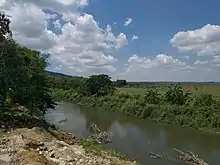| Jalaur River Jalaud River | |
|---|---|
 Jalaur River in Passi, Iloilo | |
.svg.png.webp) .svg.png.webp) | |
| Location | |
| Country | Philippines |
| Region | Western Visayas |
| Province | Iloilo |
| City/municipality | |
| Physical characteristics | |
| Source | Central Panay Mountain Range |
| • location | Calinog, Iloilo |
| Mouth | Guimaras Strait |
• location | Leganes, Iloilo |
• coordinates | 10°46′24″N 122°38′38″E / 10.77333°N 122.64389°E |
• elevation | 0 m (0 ft) |
| Length | 123 km (76 mi)[1] |
| Basin size | 1,503 km2 (580 sq mi)[2] |
| Discharge | |
| • location | Guimaras Strait |
| • average | 40.3 m3/s (1,420 cu ft/s)[3] |
| • minimum | 8 m3/s (280 cu ft/s)[3] |
| • maximum | 84.5 m3/s (2,980 cu ft/s)[3] |
| Basin features | |
| Tributaries | |
| • left |
|
| • right |
|
The Jalaur River, also known as Jalaud River, is the second longest river on Panay island in the Philippines,[4] with a total length of 123 km (76 mi)[1] and the second largest by drainage basin after Panay River in Capiz. The Jalaur has a drainage area of 1,503 square kilometres (580 sq mi).[2] Its source is in the Central Panay Mountain Range, west of Calinog,[1] and the river traverses east to southeast before emptying into the Guimaras Strait. It drains the eastern portion of Panay and courses through Passi City and the towns of Leganes, Zarraga, Dumangas, Barotac Nuevo, Pototan, Dingle, San Enrique, Duenas, and Calinog, all in Iloilo province.[5]
The river provides irrigation to farmlands as well as providing a source of potable water.[6]
The river is the site of the Jalaur Mega Dam project that begun in 2019.[7]
Etymology
Jalaur, also known by its variant form Jalaud, seems to be a Hispanicized form of Halawod, the river which serves as the core setting of Hinilawod, an epic poem from Panay.
Geography
The Jalaur River has an annual average discharge of 40.3 cubic metres per second (1,420 cu ft/s).[3]
The lower reached of the Jalaur River experiences seasonal flooding. When there is heavy downpour, during the months of June to September, the river overflows and floods the surrounding area. Panay island is also located within the typhoon belt, which experiences several typhoons annually, is also a major factor of flooding of the river.[8]
Municipalities/Cities

The Jalaur River passes through the following city and municipalities:
Cities:
Municipalities:
Economic importance
The Jalaur River is used in irrigating 15,519 hectares (38,350 acres) in the province of Iloilo through the Jalaur River Irrigation System.[6]
The Metro Iloilo Water District, the potable water provider for Iloilo City, sources some of its water requirement from the river.
References
- 1 2 3 Borlongan, I. G., Golez, N. V., & Lorque, F. (2010). "Physico-chemical assessment of the Jalaur River system, Iloilo, Philippines" (PDF). Silliman Journal. 51 (1): 224–246. Retrieved 4 August 2022.
{{cite journal}}: CS1 maint: multiple names: authors list (link) - 1 2 "Jalaur River Basin". riverbasin.denr.gov.ph. DENR - River Basin Control Office. Retrieved 4 August 2022.
- 1 2 3 4 "River Discharge Database – Jalaur River". Center For Sustainability & Global Environment, University of Wisconsin. September 3, 2008. Archived from the original on 2010-06-19. Retrieved 2008-09-13.
- ↑ "Iloilo – General Features (Water Resources)". Archived from the original on 2008-03-31. Retrieved 2008-09-12.
- ↑ "Western Visayas Regional Development Plan 2004–2010" (PDF). National Economic Development Authority (NEDA) – Region 6. 2004. p. 13. Retrieved 2008-09-13.
- 1 2 "Iloilo Province – Water Facilities". Archived from the original on 2008-04-05. Retrieved 2008-09-12.
- ↑ Sornito, Ime (February 26, 2019). "'A GAME CHANGER': Finally, Jalaur mega dam groundbreaking tomorrow". Panay News. Retrieved 2 January 2021.
- ↑ "Rains leave heavy crop damage in Capiz, Iloilo". Manila Times. January 14, 2007. Retrieved 2008-09-13.
External links
![]() Media related to Jalaur River at Wikimedia Commons
Media related to Jalaur River at Wikimedia Commons